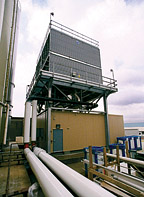
When plans called for increased capacity of the chilled water plant at its Winchester, KY, facility, management decided to replace the aging, inefficient chiller plant with a pre-fabricated, modular central chiller plant (MCCP). Martek was faced with several challenges: production could not be interrupted, there was little room to expand the plant inside the building, and they needed not only additional tonnage but also to convert from a primary-only system to a primary-secondary chilled water system. This was due to the variable demand of the process for chilled water.
Now the company's modular central chiller plant provides chilled water that is piped to the fermentation vats that are used in the production of DHA and RHA. The chilled water controls the fermentation process in the production of DHA and ARA.
Capacity Increased By 60%
A turnkey approach offered by The Stellar Group, a Jacksonville, FL, MCCP fabricator, appealed to Martek's management. Stellar's use of two MaxE™ centrifugal chillers equipped with OptiSpeed™ variable-speed control from York International Corp. enabled Martek to increase the tonnage of its chiller plant capacity by 60% while using only one-half the space.By using VSDs on the chiller as well as the primary chilled water and condenser water pumps, Martek was able to achieve optimal system efficiency. It is estimated that energy savings will be greater than 25% over the aging ammonia equipment system, due to the new chillers and the use of VSDs.
According to Martek executive vice president Paul Kelley, "The real value of a modular central chiller plant is that the manufacturer of the plant takes responsibility for the design as well as the installation, startup, performance, and in our case, the maintenance of the plant. In this particular project, we did not use the services of an engineering firm, and while the plant manufacturer addressed the chilled water issues, we continued to focus on our production process."
At the time of the planned replacement of the chiller plant, the Winchester facility was running at a very high level of production. According to David Welsch, senior project coordinator, "There was a concern that any new construction not be invasive on the production process. I have to say that the installation of the modular chiller plant was one of the smoothest construction projects I've seen of this type."
Savings to Martek were significant, in terms of both time and costs. "We wrote a purchase order for the modular central chiller plant in December, broke ground the second week of February, and had the plant online by April 14 of last year. The actual design process took approximately six weeks, as compared to the average six months for a stick-built plant."
Critical Coordination
In terms of cost savings, Wells cited savings of at least 15% as a result of the company's decision to install an MCCP. The MCCP's smaller footprint also allows Martek room for future expansion in a facility described by management as "very tight."Because the MCCP was not being assembled onsite, coordination between activities in the field and those at the MCCP manufacturer was critical. To ease the concern that field measurements match those of the MCCP, the MCCP manufacturer placed an area service manager onsite for the duration of the job to pay close attention to details and facilitate an ongoing dialog between the construction site and the module manufacturer.
"The evolution of the modular central chiller plant resembles the evolution of the chiller itself," according to Kurt M. Liebendorfer, senior vice president, The Stellar Group. "Today, the vast majority of chillers are packaged by the original manufacturer, with the main components - motor, compressor, heat exchangers, starter, and controls - integrated, tested and shipped as a unit."
That same thinking is now being applied to the entire chiller plant, Liebendorfer said. Fabricators like Stellar pre-engineer all the central plant equipment (chillers, plus pumps, cooling towers, starters, controls) that is traditionally shipped to a jobsite as individual components. These specialized fabricators package the equipment in an enclosed skid that is pre-piped, pre-wired, tested, and shipped to the jobsite as a module. After the module is placed onsite, only water and power connections need to be made. ES
